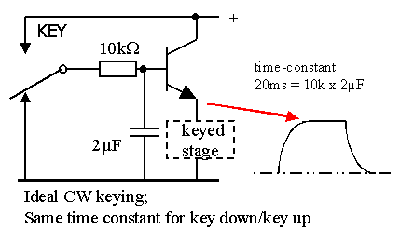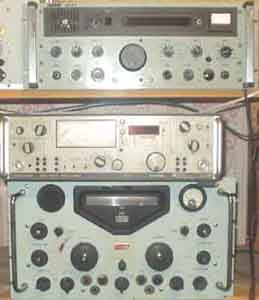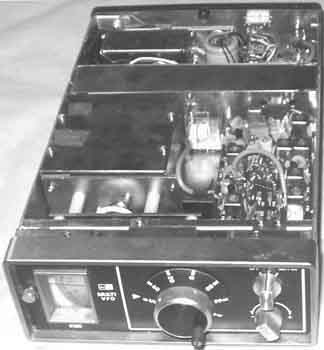

Signal
Intelligibility and CW key-click problem
*** B. Amateur radio and related equipment ***
|
FT-902 with |
The KEY-CLICK Problem.
If you are care for other operators, the first thing to do is to
make sure that your transmitter is OK, the
worst problem is the KEY-CLICK problem. Many plastic radio
operators believe they have the right
to transmit whatever they want if they use the latest junk on the
marked. If you are among those lids, don't
read further, the following information is not meant for you, in
opposite case see what W8JI writes on
http://www.w8ji.com/what_causes_clicks.htm
or for FT1000 http://www.w8ji.com/keyclicks.htm
SM5BSZ has also provided some material on the problem, but did
not show how to solve it
in practice according to his theory. We had some dissagreement in
early 80's and I went to my
lecturer who made the maths in his xmas holidays. Have a
handwritten paper for ASK and FSK
(Amplitude shift keying and frequency shift keying), but it is in
Norwegian - although the formulas
may not be in a particular language.......
If you understand the problem, you only need to add some
capacitors - and in some cases - resistors,
to reduce the problem dramatically.Often manufacturers like Yaesu
are aware of the problem, and they
have taken steps to avoid it without knowing that have increased
the problem instead of improving
(FT-7/FT-221/FT-225). Almost as bad as not having proper time
constants in the keyed circuits,
is when you have different time constants in two or more keyed
stages. Very simple mathematics
is needed to understand time constants, and the key-on/off
threshold levels are also important
to understand. This means that you cannot key a stage very far
beyond cutoff and expect to
have proper timeconstant in this and that it follows another
circuit, the keying may sound bad with
poor intelligibility of the signal.
CW key-filter specifications.
W8JI writes: The ARRL recommends a 5 mS
rise and 5 mS fall time for CW, based on data in section 2.202 of
FCC
rules and CCIR Radio regulations. But this is only a simplified
version. The 5milli-second timedelay applies to a
first order low-pass-filter which is a very poor, but
satisfactory mean to avoid key-clicks. You may just as well use
a 500Hz third order low passfilter using some stages of
semiconductors or simplified with op-amps and
CMOS-devices. I've got good reports from local OPS using this,
and the transmitter is also capable of transmitting
2000LPM (400 WPM) morse without too much distortion. I worked
UA1ZCL on 2m (2000km) on cw
meteorscatter and other with this speed, but now such speed is
regarded as slow.
The importance of Signal
intelligibility
LA4O club should operate LA1X at an
exhibition in Oslo in 68. We had got the latest Japanese rubbish
on the marked, but nobody cared to approach the stand. It was an
obvious demonstration of operation for
certain strange persons and the public avoided us. So Gudmund,
LA2DL understood that something was
going really wrong. He got home and collected his own Drake
TR-4 rig and later installed it at the stand.
And just as we had removed the Japanese junk and installed the
Drake rig, the stand caught considerable
interest, now the public suddenly understood that what was going
on on amateur bands was conversations
which everybody could cope with. LA2DL's initiative was important
and after this I was even more
critical to improper designed rigs. Still sometimes I hear
somebody comment that
"don't know about the receiver, but the transmitter is
good". So, for a period I accepted only Drake equipment
for the good intelligibility from the receiver sound, got the 2-B
in december 68, TR-4 in 74, and R-4C in 76,
and another 2-B in 77, but some Japanese equipment has been
useful, and I've also learnt how to improve the
sickness, which is usually caused by improper AGC time constants
and in two occasions, improper product
detector, but quite simple modifications - when you learnt what
was to remove or add. Have therefore
kept FT-7 since 82, FT-902 since 88, IC202 since 85, had Trio
TR7010 and Sommerkamp FL-dx-500 for
a period of time until they were donated to some friends.
Old YAESU rigs
The first and most important point to mention for such old rigs
using edge-contacts on the PCBs, is
that the rig starts to fail after 15-20 years. I had some
intermittent frequency stability problems in FT-902,
and believed it was the 6V regulator. This was modified and
worked fine for some years. OZ1HDA has the
same problem with his FT-901. Got a tip from a
service-man, he said it was important to clean the edge-
contacts with iso-propanol (blue windscreen washer liquid works
fine), use a brush and cover the contacts
with a very thin layer of vaseline afterwords. It solved all my
problems with FT-902, and it is still my main
transceiver, operating with it on HF as well as VHF/UHF with
different SSB transverters.
FT-101B, FT-221, FT-225 has some serious problems which seem
impossible to solve.
The carrier oscillator spreads signals through the receiver, and
you will see that if you
remove the carrier connections to the product detector it will
still demodulate SSB.
I spent a week trying to solve this for FT-221, and reduced the
problem somewhat,
but not by far as much it was needed. Spent also several weeks
with FT-101B, it
is totally impossible to build IF-derived AGC detectors for this,
so I used it only as
transmitter with Drake R-4C receiver. FT-7 and FT-902 have not
this kind of problems.
see page B.52 for FT200/FT250
VOX
I hate VOX, and it is disabled on all my equipment (now
FT-7, FT-901 and FT-902). Believe it might
work in some equipment, but not in the rigs I have, so it is
possible to use the available front controls
for some better purposes, like CW drive level control,
SSB-squelch (AGC derived) and other

The ideal key filter is shown here. But application of this is
only possible when you build the
transmitter yourself, normally you cannot decide to have the so
easy task......
Se forøvrig følgende artikler om
Yaesu/Sommerkamp utstyr:
FL-DX-500 Ombyging av
sender
LA8AK QTC 87-12-530
FL-DX-400/500 Forbedringer +150V
REG LA8AK
AR 75-01-008
FL-dx-500 på 30m
bandet
SM7VY QTC 85-05-185
FR-dx-500 på 30m
bandet
SM7VY QTC 85-05-185
FT-221R
modifikasjon
AR 81-09-256
FT-221R
ombygging
AR 81-10-293
FT-101ZD på de nya
banden
SM5RN QTC 85-03-091
FT-221R forbedring
(3)
AR 79-10-274
FT-221R forbedring
(2)
AR 79-06-176
FL-DX-500 Forbedret
ALC
AR 74-12-275
FT-277(FT-101B) Forbedring av
følsomheten
AR 80-04-104
FT-101B Nøklingstrinn (FT-250/FLDX500/FTDX500)LA8AK
AR 90-03-071
FT-250 Interferens fra 40m
kringkastere
AR 83-07-203
FT-480R
Modifikasjon
AR 85-12-337
FT-7 Rent CW-signal (max 1000
lpm)
LA8AK QTC 83-03-086
FT-901-DM Modifikasjon (1) Klikk og
NB LA3ZL AR 79-06-175
FT-77 Forbedring av
selektiviteten
QTC 88-01-009
FT-250 Tilkopling av converter/transverter
LA8AK AR 71-05-108
FT-7
TX-gain
LA8AK QTC 87-01-010
FT-757GX Datorstyring av -(QTC 85:03:
) SM6CPI QTC 85-05-191
FT-901-DM Modifikasjon (2)
Noiseblanker LA3ZL AR 79-08-212
FT-7
SSB-squelch
LA8AK QTC 85-07-282
FT-7 Forbedring af-(10m/xtalcal/transv etc)
LA8AK OZ 83-02-.6.
FT-101 Forbedret
AGC
OZ6WP OZ 78-03-119
FT-7 Utvid 10m, transverter
tilkopling LA8AK QTC
85-09-325
FT-221R Forbedring av
nøkkelklikk
AR 82-02-060
FT-221R forbedring
(1)
AR 79-02-045
FT-250
Modifikasjoner
LA8AK AR 69-11-239
FT-221R Forbedring av
følsomheten
AR 80-04-104
FT-7 SSB squelch for
mottaker
LA8AK AR 83-12-339
FT-480R Modifisering (2)
-tillegg
SM0LBR QTC 83-04-128
FT-480R Scanstart
for-
QTC 83-10-336
FT-901/902 Forbedringer
(2)
LA8AK AR 90-07-206
FT-901/902
Nøkling
LA8AK AR 89-06-165
FT-100 Forbedret
AGC
OZ4DX OZ 70-09-321
FT-7 Omkopling av
xtal-kalibrator
LA8AK AR 84-02-040
FT-7 Feil i tidlig
utgave
LA8AK AR 83-02-041
FT-901/902 Forbedringer
(1)
LA8AK AR 89-02-038
FT-726
Forbedringer
LA7BI AR
89-04-124
FT-726 - forbedring av produkt detektor LA7BI LA8AK
AR 93-10-277
TR-7010 - produkt detektor
LA8AK AR 93-10-277
FT-101B med transverter,boks for utkopling av PA-rør AR
83-04-127
FT-7 Regulering av uteffekten,
TX-gain LA8AK AR
83-10-275
FT-250 Forbedret
AGC
LA8AK AR 78-04-101
FT-221 Kritisk undersøkelse og modifikasjoner LA8AK QTC
89-07-
FT-200/250 Forbedring av
AGC
LA8AK OZ 78-03-120
FT-DX-100/150 MOSFET i HF
trinnet
AR 73-12-293
FT-290R Svakheter i
transceiveren
AR 82-06-197
FT-901/902
Noise-blanker
LA8AK AR 89-02-039
FT-250
Drive-problem
AR 78-05-133
FT-250 Intermodulasjon fra xtal
kalibrator
AR 77-01-004
FT-902 Xtal kalibrator kan gi intermodulasjon LA8AK
AR 89-04-105
FT-101B eliminering av
nøkkelklikk
AR 81-04-100
FT-901/902 Processor
(RF-clipper)
LA8AK AR 89-02-039
FT-757GX Datorstyrning
av
I/SM6CPI QTC 85-03-100
FT-757GX Direkte frekvensinntasting/brukertest LA6PB AR
88-03-070
FT-26, test av
yaesu
OZ 92-01-017
FT-5200 2m/70cm, test
af-
OZ 92-03-141
FT-7 Xtal kalibrator kan gi intermodulasjon
LA8AK AR 89-04-105
FT-736, Amatørradioklubben Københavns teknikum måler- OZ
94-03-143
FT-747GX styring
av-
AR 94-03-069
FT-890, test av
-
OZ 92-10-556
FT-901/902 forbedringer for
HF/VHF
LA8AK OZ 93-07-407
FT-901/902 Forbedringer af
-
LA8AK OZ 93-07-407
FT-901/902 rettelse for OZ
7/93
OZ 93-11-661
FT-990, test af
-
OZ5RM OZ1AWJ OZ 92-05-258
FT-726 og TR-7010 SSB RX kvalitetsproblemer TR-122
AR 93-10-277
Mods
Intro
Need your help:
In 1967-68 I borrowed a Starflite 390(?)
transmitter - with Heath VF1 VFO - from NRRL, but later
I have found no
references about this rig. So I would be very interested if
somebody would give me some more info, possibly circuit diagram
and data.
Built my own 80m 5W PEP solid state SSB transmitter in 1967,
based on an article in CQ-DL (DJ8MC?), it was
described as a mobile transceiver, but I never needed the
receiver since it transceived with my Heath SB-300. Purchased
an HX-20 transmitter in 68, and when I've tested 49 modification
on it I sold it to LA6VM, who had already bought my
Drake 2-C, and I bought Sommerkamp FT-250, which was combined
with Drake 2-B, I was surpirsed how good it
was and immediately decided to get rid of SB-300 and buy 2-B, but
I never liked the 2-C which I had one and a
half year earlier, the worst was that it didn't cover 10m and had
no passband tuning.
Have made extensive experiments and modifications for the
following sets:
Collins 51-S, Drake 2-B, R-4C, TR-4, Heathkit HX-20, SB-300/301,
Trio TS-500, TR-7010, IC255E, IC202E,
Yaesu (Sommerkamp) FT-7, FT-101B, FT-250, FT-902, FL-dx-500,
May publish more information if it is some interest for it, and I
find time to dig into old books, but please note that
FT-7 IS NOT FT-7B


Need info and schematic for this: FDK AC/DC Multi VFO